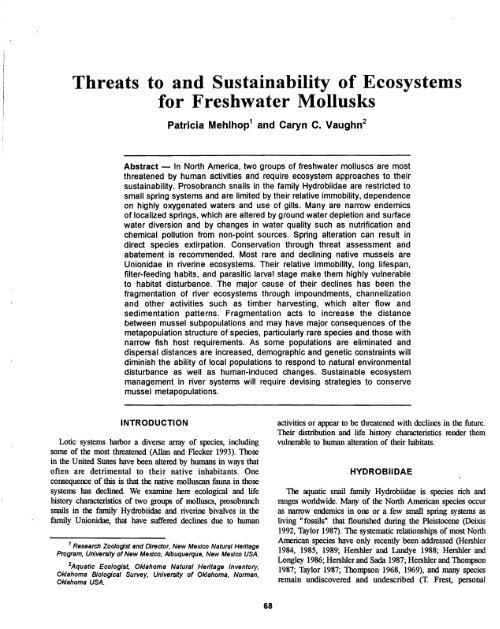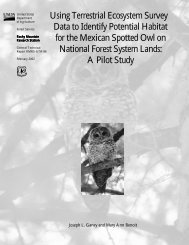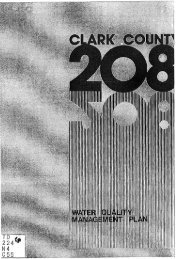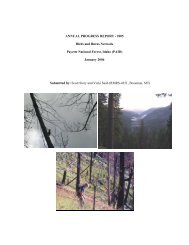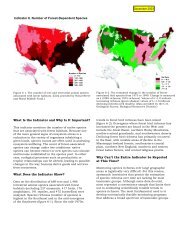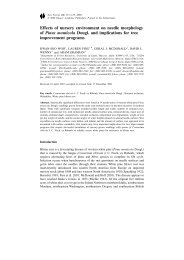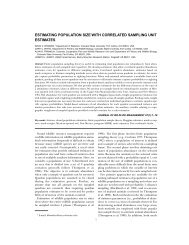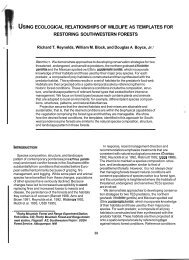Threats to and Sustainability of Ecosystems for Freshwater Mollusks
Threats to and Sustainability of Ecosystems for Freshwater Mollusks
Threats to and Sustainability of Ecosystems for Freshwater Mollusks
Create successful ePaper yourself
Turn your PDF publications into a flip-book with our unique Google optimized e-Paper software.
<strong>Threats</strong> <strong>to</strong> <strong>and</strong> <strong>Sustainability</strong> <strong>of</strong> <strong>Ecosystems</strong><br />
<strong>for</strong> <strong>Freshwater</strong> <strong>Mollusks</strong><br />
Patricia Mehlhop 1 <strong>and</strong> Caryn C. Vaughn 2<br />
Abstract - In North America, two groups <strong>of</strong> freshwater molluscs are most<br />
threatened by human activities <strong>and</strong> require ecosystem approaches <strong>to</strong> their<br />
sustainability. Prosobranch snails in the family Hydrobiidae are restricted <strong>to</strong><br />
small spring systems <strong>and</strong> are limited by their relative immobility, dependence<br />
on highly oxygenated waters <strong>and</strong> use <strong>of</strong> gills. Many are narrow endemics<br />
<strong>of</strong> localized springs, which are altered by ground water depletion <strong>and</strong> surface<br />
water diversion <strong>and</strong> by changes in water quality such as nutrification <strong>and</strong><br />
chemical pollution from non-point sources. Spring alteration can resuH in<br />
direct species extirpation. Conservation through threat assessment <strong>and</strong><br />
abatement is recommended. Most rare <strong>and</strong> declining native mussels are<br />
Unionidae in riverine ecosystems. Their relative immobility, long lifespan,<br />
filter-feeding habits, <strong>and</strong> parasitic larval stage make them highly vulnerable<br />
<strong>to</strong> habitat disturbance. The major cause <strong>of</strong> their declines has been the<br />
fragmentation <strong>of</strong> river ecosystems through impoundments, channelization<br />
<strong>and</strong> other activities such as timber harvesting, which alter flow <strong>and</strong><br />
sedimentation patterns. Fragmentation acts <strong>to</strong> increase the distance<br />
between mussel subpopulations <strong>and</strong> may have major consequences <strong>of</strong> the<br />
metapopulation structure <strong>of</strong> species, particularly rare species <strong>and</strong> those with<br />
narrow fish host requirements. As some populations are eliminated <strong>and</strong><br />
dispersal distances are increased, demographic <strong>and</strong> genetic constraints will<br />
diminish the ability <strong>of</strong> local populations <strong>to</strong> respond <strong>to</strong> natural environmental<br />
disturbance as well as human-induced changes. Sustainable ecosystem<br />
management in river systems will require devising strategies <strong>to</strong> conserve<br />
mussel metapopulations.<br />
INTRODUCTION<br />
Lotic systems haIbor a diverse army <strong>of</strong> species, including<br />
some <strong>of</strong> the most threatened (Allan <strong>and</strong> Flecker 1993). Those<br />
in the United States have been altered by humans in ways that<br />
<strong>of</strong>ten are detrimental <strong>to</strong> their native inhabitants. One<br />
consequence <strong>of</strong> this is that the native molluscan fauna in those<br />
systems has declined. We examine here ecological <strong>and</strong> life<br />
his<strong>to</strong>ry characteristics <strong>of</strong> two groups <strong>of</strong> molluscs, prosobranch<br />
snails in the family Hydrobiidae <strong>and</strong> riverine bivalves in the<br />
family Unionidae, that have suffered declines due <strong>to</strong> lmman<br />
1 Research Zoologst <strong>and</strong> Direc<strong>to</strong>r, New Mexico Natural Heritage<br />
Program, University <strong>of</strong> New Mexico, Albuquerque, New Mexico USA.<br />
2Aquatic /Ecologist, Oklahoma Natural Heritage Inven<strong>to</strong>ry,<br />
Oklahoma Biological Survey, University <strong>of</strong> Oklahoma, Norman,<br />
Oklahoma USA.<br />
68<br />
activities or appear <strong>to</strong> be threatened with declines in the future.<br />
Their distribution <strong>and</strong> life his<strong>to</strong>ry characteristics render them<br />
vulnerable <strong>to</strong> human alteration <strong>of</strong> their habitats.<br />
HYDROBIIDAE<br />
The aquatic snail fanrily Hydrobiidae is species rich <strong>and</strong><br />
ranges worldwide. Many <strong>of</strong> the North American species occur<br />
as narrow endemics in one or a few small spring systems as<br />
living "fossils" that flourished during the Pleis<strong>to</strong>cene (Deixis<br />
1992, Taylor 1987). The systematic relationships <strong>of</strong> most North<br />
American species have only recently been addressed (Hershler<br />
1984, 1985, 1989; Hershler <strong>and</strong> L<strong>and</strong>ye 1988; Hershler <strong>and</strong><br />
Longley 1986; Hershler <strong>and</strong> Sada 1987; Hershler <strong>and</strong> Thompson<br />
1987; Taylor 1987; Thompson 1968, 1969), <strong>and</strong> many species<br />
remain undiscovered <strong>and</strong> undescribed (T. Frest, personal
communication, R. Hershler, personal communication).<br />
Currently, 5 species have been listed as endangered (Federal<br />
Register 1991a, 1992), 10 are considered <strong>to</strong> merit listing as<br />
endangered or threatened, <strong>and</strong> 84 are under review <strong>for</strong> listing<br />
(Federal Register 1991b) (fig. 1).<br />
NO. OF SPECIES<br />
100<br />
80<br />
60<br />
40<br />
20<br />
OL--------------------<br />
ENDANGERED THREATENED C1 C2<br />
PROTECTION STATUS<br />
Figure 1.--Federal status <strong>to</strong>ward listing <strong>of</strong> rare or declining snails<br />
<strong>of</strong> the family Hydrobiidae in the United States. His<strong>to</strong>gram<br />
shows number <strong>of</strong> species listed as endangered or<br />
threatened, number <strong>of</strong> c<strong>and</strong>idate 1 species (species that<br />
merit listing) <strong>and</strong> number <strong>of</strong> c<strong>and</strong>idate 2 species (species<br />
requiring further study <strong>to</strong> determine status).<br />
<strong>Freshwater</strong> hydrobiids are indica<strong>to</strong>rs <strong>of</strong> artesian spring<br />
ecosystems with permanent, flowing, highly oxygenated waters<br />
(ponder et alI989). The waters may be highly mineralized, but<br />
must be relatively unpolluted. When hydrobiids occupy a<br />
significant portion <strong>of</strong> a spring system, it is an indication that the<br />
system is functioning <strong>and</strong> intact.<br />
Life His<strong>to</strong>ry <strong>and</strong> Ecological Characteristics<br />
Hydrobiids are gill breathing <strong>and</strong> thus in<strong>to</strong>lerant <strong>of</strong> dIying or<br />
anaerobic conditions. Reproduction occurs annually or more<br />
<strong>of</strong>ten depending on water temperature (Deixis 1992, Hershler<br />
1984, Mladenka 1992, Taylor 1987), <strong>and</strong> smvivorship is<br />
estimated <strong>to</strong> be approximately one year (Mladenka 1992, T. Frest<br />
personal communication). They are found in flowing waters,<br />
<strong>of</strong>ten in thermal springs. The ecology <strong>of</strong> these snails in North<br />
America bas received little study until recently (eg., Deixis 1992,<br />
Hershler 1984, M1adenka 1992, Reiter 1992). Here we examine<br />
ecological data <strong>for</strong> 59 species in the subfamilies Hydrobiinae<br />
<strong>and</strong> Lit<strong>to</strong>ridininae that have been reported as rare or threatened,<br />
or which occur in a narrow range in springs <strong>and</strong> their associated<br />
outflows. The sources <strong>of</strong> in<strong>for</strong>mation consulted <strong>for</strong> each species<br />
are given in Appendix 1.<br />
Of 59 species, most occur at only a single site <strong>and</strong> most <strong>of</strong><br />
the remaining occur at only two or three sites (fig. 2).<br />
Occurrences represent single springs with no surface connection<br />
69<br />
<strong>to</strong> other irthabited springs or parts <strong>of</strong> spring systems separated<br />
by more than 500 m <strong>of</strong> uninhabited waters. Because studies have<br />
not been conducted on gene flow among occurrences, it is not<br />
known whether an occurrence is the equivalent <strong>of</strong> a population<br />
NUMBER OF SPECIES<br />
30<br />
2-3 4-7 8-15 >15<br />
NUMBER OF OCCURRENCES<br />
Figure 2.-Number <strong>of</strong> known occurrences per species <strong>of</strong><br />
hydrobiid snails that are rare or threatened or have a narrow<br />
range <strong>of</strong> distribution.<br />
Maximum occupied range was estimated in miles <strong>for</strong> 58<br />
species as the greatest linear distance between two occupied<br />
points. Of those, 43% are known <strong>to</strong> occupy a range less than<br />
0.1 mile, <strong>and</strong> less than golo have a range greater than 10 linear<br />
miles (fig. 3).<br />
NO. OF SPECIES<br />
30<br />
25<br />
20<br />
15<br />
10<br />
5<br />
0<br />
N·58<br />
10<br />
RANGE (MILES)<br />
Figure 3.-Maximum occupied range per species (linear miles) <strong>of</strong><br />
hydrobiids in the subfamilies Hydrobiinae <strong>and</strong> Lit<strong>to</strong>ridininae<br />
that are rare, threatened or have a narrow range <strong>of</strong><br />
distribution.
seasonal <strong>and</strong> on a scale <strong>of</strong> a few <strong>to</strong> an estimated maximum <strong>of</strong><br />
100 meters (Green et al. 1985). There<strong>for</strong>e, unlike many stream<br />
organisms such as fish <strong>and</strong> aquatic insects (Townsend 1989),<br />
adult mussels have no refugia from disturbance events in<br />
streams. In addition, their filter-feeding habits make them<br />
especially vulnerable <strong>to</strong> sedimentation <strong>and</strong> chemical pollution<br />
events.<br />
<strong>Threats</strong> <strong>and</strong> Causes <strong>of</strong> Decline<br />
Species associations, species richness, metapopulation<br />
structure, <strong>and</strong> densities <strong>and</strong> population size structure <strong>of</strong><br />
individual species are all potentially impacted by <strong>for</strong>est<br />
management practices. In addition, any effects on fish<br />
communities may ultimately affect mussels as well. Watters<br />
(1992) recently found high correlation between fish distribution<br />
<strong>and</strong> diversity <strong>and</strong> mussel distnbution <strong>and</strong> diversity.<br />
One major cause <strong>of</strong> mussel declines has been the<br />
fragmentation <strong>of</strong> river drainages through impoundments,<br />
channelization <strong>and</strong> other activities, such as timber-harvesting,<br />
which alter flow <strong>and</strong> sedimentation patterns. Declines in mussel<br />
species <strong>for</strong> various river drainages <strong>and</strong> the disturbance fac<strong>to</strong>r<br />
associated with these declines are shown in Table 2.<br />
TImber harvesting operations can have significant effects on<br />
both stream water quantity <strong>and</strong> quality. The influence <strong>of</strong><br />
catchment vegetation on stream discharge is dependent on a<br />
large number <strong>of</strong> variables, many <strong>of</strong> which are site-specific.<br />
However, in general, removal <strong>of</strong> <strong>for</strong>est vegetation increases<br />
stream run<strong>of</strong>f (Campbell <strong>and</strong> Doeg 1989). Increased flows have<br />
the potential <strong>to</strong> alter the distnbution <strong>of</strong> sediment through scour,<br />
flushing, <strong>and</strong> deposition <strong>of</strong> newly eroded materials from the<br />
banks. Increased flows also have the potential <strong>to</strong> activate the<br />
bed. Bedload movement will wreak havoc on the survival <strong>of</strong><br />
many mussels, particularly juveniles (Young <strong>and</strong> Williams<br />
1983). Erosion caused by increased flows at one location results<br />
in deposition <strong>of</strong> this material further downstream. This "zone<br />
Drainage<br />
Upper Tennessee River<br />
Middle <strong>and</strong> Lower Tennessee R.<br />
sedimentation<br />
Tombigbee River at Epes, AL<br />
S<strong>to</strong>nes River, TN<br />
Upper S<strong>to</strong>nes River, TN<br />
Sugar Creek, IN<br />
Illinois River, IL<br />
Kankakee River, IL<br />
Kaskaskia River, IL<br />
Vermillion River, IL<br />
Embarras River, IL<br />
Little Wabash River, IL<br />
<strong>of</strong> aggradation" results in an increased width/depth ratio <strong>of</strong> that<br />
portion <strong>of</strong> the channel. As width/depth ratios increase the<br />
potential <strong>for</strong> bedload transport also increases. Thus, increased<br />
flows cause habitat loss through both sediment deposition <strong>and</strong><br />
increased bed mobility. In the long term, higher base flow levels<br />
<strong>and</strong> shorter periods between peak flood periods will decrease<br />
habitat complexity by preventing the <strong>for</strong>mation <strong>of</strong> isl<strong>and</strong>s,<br />
establishment <strong>of</strong>macrophyte beds, etc. (Frissell 1986). Stabilized<br />
sediments, s<strong>and</strong> bars, <strong>and</strong> low flow areas, are all preferred<br />
unionid habitats (Hartfield <strong>and</strong> Ebert 1986, Payne <strong>and</strong> Miller<br />
1989, Stem 1983, Way et al. 1990). It is around these" complex"<br />
areas that most mussel beds, <strong>and</strong> indeed the highest diversity <strong>of</strong><br />
stream fauna, are found.<br />
Road-building activities <strong>and</strong> low water crossings associated<br />
with logging can lead <strong>to</strong> the development <strong>of</strong> "headcuts", or<br />
migrating knickpoints in the channel remote from areas <strong>of</strong> actual<br />
modification. Headcuts result in severe bank erosion, channel<br />
widening, <strong>and</strong> depth reduction <strong>and</strong> can have devastating effects<br />
on the mollusc fauna (Hart 1993).<br />
Stream organisms, including mussels, have evolved in rivers<br />
that experience seasonal low-flow <strong>and</strong> high-flow periods<br />
(Meador <strong>and</strong> Matthews 1992). Fluctuating flows, especially if<br />
there will be lower flows <strong>for</strong> long periods <strong>of</strong> time, will result<br />
in the str<strong>and</strong>ing <strong>of</strong> many mussels. Unlike fish species which can<br />
move rapidly in <strong>and</strong> out <strong>of</strong> microhabitats with changes in water<br />
levels, mussels move very slowly <strong>and</strong> are unable <strong>to</strong> respond <strong>to</strong><br />
sudden drawdowns. Even if str<strong>and</strong>ing doesn't actually kill a<br />
mussel, desiccation <strong>and</strong> thermal extremes will cause<br />
physiological stress <strong>and</strong> may reduce reproductive potential<br />
(McMahon 1991).<br />
Fluctuating flows also mean that transport <strong>of</strong> particulates will<br />
vary. Depending on the flow schedule <strong>and</strong> the materials normally<br />
transported in the water column, there is the potential <strong>for</strong> loss<br />
<strong>of</strong> organics which are the food base <strong>for</strong> mussels.<br />
Flow alteration not only has the potential <strong>to</strong> pr<strong>of</strong>oundly affect<br />
the stream fauna, but riparian fauna as well. Flood waters that<br />
normally recharge soils <strong>and</strong> aquifers may be rapidly exported<br />
Table 2. - Reported loss <strong>of</strong> unionid mussel species from rivers <strong>and</strong> fac<strong>to</strong>rs contributing <strong>to</strong> the losses.<br />
% Species Lost<br />
36%<br />
13%<br />
68%<br />
40%<br />
25%<br />
20%<br />
51%<br />
25%<br />
38%<br />
40%<br />
39%<br />
24%<br />
Major Fac<strong>to</strong>r in Decline<br />
Impoundments, sedimentation<br />
Impoundments, channelization,<br />
Impoundment<br />
Impoundment<br />
Gravel dredging, water quality<br />
Impoundments, channelization,<br />
sedimentation<br />
Siltation<br />
Siltation<br />
(80% reduction in numbers <strong>of</strong> individuals)<br />
73<br />
Source<br />
Starnes <strong>and</strong> Bogan (1988)<br />
Starnes <strong>and</strong> Bogan (1988)<br />
Vllilliams et al. (1992)<br />
Schmidt et al. (1989)<br />
Schmidt et al. (1989)<br />
Harmon (1992)<br />
Starret (1971)<br />
Suloway (1981)<br />
Suloway et al. (1981)<br />
Cummings (1991)<br />
Cummings (1991)<br />
Cummings (1991)
downriver. Lowered water tables may cause shrinkage <strong>of</strong> the<br />
riparian corridor <strong>and</strong> shifts in terrestrial species composition<br />
(Allan <strong>and</strong> Flecker 1993, Smith et al. 1991).<br />
Mussels are most successful where water velocities are low<br />
enough <strong>to</strong> allow sediment stability but high enough <strong>to</strong> prevent<br />
excessive siltation (Salmon <strong>and</strong> Green 1983, Way et al. 1990).<br />
Thus, well-oxygenated, coarse-s<strong>and</strong> <strong>and</strong> s<strong>and</strong>-gravel beds<br />
comprise optimal habitat (McMahon 1991). Sediment deposition<br />
not only removes or moves habitat, but also clogs mussel<br />
siphons (i.e. smothers them) <strong>and</strong> interferes with feeding <strong>and</strong><br />
reproduction (Dennis 1984, Aldridge et al. 1987). In addition,<br />
because mussels are sedentaty filter-feeders, they are particularly<br />
sensitive <strong>to</strong> changes in water quality (Havlik <strong>and</strong> Matking 1987).<br />
Demographic Consequences<br />
Because <strong>of</strong> this dependence on the appropriate substrate <strong>and</strong><br />
flow conditions, freshwater mussels are already naturally<br />
patchily distnbuted in rivers. Fragmentation acts <strong>to</strong> increase<br />
patchiness <strong>and</strong> <strong>to</strong> increase the distance between patches. These<br />
effects may have major consequences <strong>for</strong> the metapopulation<br />
(i.e. local or subpopulations connected by infrequent dispersal)<br />
structure <strong>of</strong> mussel species, particularly rare species <strong>and</strong> those<br />
with narrow fish-host requirements (Vaughn 1993). As some<br />
subpopulations are eliminated <strong>and</strong> dispersal distances are<br />
increased between other subpopulations, demographic <strong>and</strong><br />
I, genetic constraints will diminish the ability <strong>of</strong> mussels <strong>to</strong><br />
respond <strong>to</strong> even natural s<strong>to</strong>chastic events much less<br />
human-induced environmental change (WIlcox 1986, Mwphy et<br />
al. 1990).<br />
Forest Management Strategies<br />
Managing <strong>for</strong>ests <strong>to</strong> maintain fully functional riverine<br />
ecosystems is the best way <strong>to</strong> protect unionid populations in<br />
National Forests. Best l<strong>and</strong>-use practices should strive <strong>to</strong><br />
maintain an uncut riparian corridor at least as wide as the<br />
predicted 100 year channel me<strong>and</strong>er (Boon et al. 1992). Forest<br />
managers should seek <strong>to</strong> minimize the use <strong>of</strong> biocides <strong>and</strong><br />
encourage selective logging rather than clear-cutting whenever<br />
possible. Disturbances such as low-water crossing which were<br />
thought <strong>to</strong> have temponuy effects are now known <strong>to</strong> have<br />
long-term detrimental effects on mussel populations through the<br />
fonnation <strong>of</strong> migrating headcuts. Managing <strong>for</strong>ests from an<br />
ecosystem perspective nrust include long-term moni<strong>to</strong>ring <strong>of</strong><br />
unionid populations.<br />
74<br />
LITERATURE CITED<br />
Aldridge, D.W.; Payne, B.S; <strong>and</strong> Miller, A.C. 1987. The effects<br />
<strong>of</strong> intermittent exposure <strong>to</strong> suspended solids <strong>and</strong> tUIbulence<br />
on three species <strong>of</strong> freshwater mussels. Environmental<br />
Pollution 45:17-28.<br />
Allan. JD. <strong>and</strong> Flecker, A.S. 1993. Biodiversity conservation in<br />
running waters. BioScience 43:32-43.<br />
Arizona Heritage Data Management System. 1992. Unpublished<br />
records <strong>of</strong> rare mollusks from the Biological Conservation '<br />
Database. Arizona Game <strong>and</strong> Fish Department, Phoenix, AZ.<br />
Boon, P J.; Calow, P.; <strong>and</strong> Petts, G.E. 1992. River Conservation<br />
<strong>and</strong> Management. John Wiley <strong>and</strong> Sons Ltd.<br />
Cali<strong>for</strong>nia Natural Heritage Divisioll 1992. Unpublished records<br />
<strong>of</strong> rare mollusks from the Biological Conservation Database.<br />
Cali<strong>for</strong>nia Department <strong>of</strong> Fish <strong>and</strong> Game, Sacramen<strong>to</strong>, CA<br />
Campbell, 1. C. <strong>and</strong> Doeg, T.J. 1989. Impact <strong>of</strong> timber hatvesting<br />
<strong>and</strong> production on streams: a review. Australian Journal <strong>of</strong><br />
Marine <strong>and</strong> <strong>Freshwater</strong> Research 40: 519-539.<br />
Clarlce, AH. 1987. Status survey <strong>of</strong> Lampsi/is streckeri FrieISOn<br />
(1927) <strong>and</strong> Arcidens wheeler; (Ortmann & Walker, 1912).<br />
Unpublished report no. 14-16-0004-86-057 <strong>to</strong> the U.S. Fish<br />
<strong>and</strong> Wildlife Service, Jackson, Mississippi.<br />
Crumpacker, D.W.; Hodge, S.W.; Friedley, D.; <strong>and</strong> Gregg, W.P.<br />
1988. A prelimiruuy assessment <strong>of</strong> the status <strong>of</strong> major<br />
terrestrial <strong>and</strong> wetl<strong>and</strong> ecosystems on federal <strong>and</strong> indian l<strong>and</strong>s<br />
in the united states. Conservation Biology 2:101-115.<br />
Cummings, K.S. 1991. The aquatic mollusca <strong>of</strong> Illinois. Illinois<br />
Natural His<strong>to</strong>ty Survey Bulletin 34:428-438.<br />
Deixis 1992. Distnbution <strong>and</strong> ecology <strong>of</strong> the endemic <strong>and</strong> relict<br />
mollusc fauna <strong>of</strong> Idaho mc's thous<strong>and</strong> springs preserve.<br />
Unpublished report <strong>to</strong> The Nature Conservancy <strong>of</strong> Idaho. pp.<br />
70.<br />
Dennis, SD. 1984. Distnbutional analysis <strong>of</strong> the freshwater<br />
mussel fauna <strong>of</strong> the Tennessee River system, with special<br />
reference <strong>to</strong> possible limiting effects <strong>of</strong> siltation. PhD.<br />
dissertation, Virginia Polytechnic Institute <strong>and</strong> State<br />
University, Blacksburg, Virginia<br />
Federal Register. 1991a. Endangered <strong>and</strong> threatened wildlife <strong>and</strong><br />
plants; final rule <strong>to</strong> list the Alamosa springsnail <strong>and</strong> the<br />
Socorro springs nail as endangered. Federal Register<br />
56:49646-49649.<br />
Federal Register. 1991b. Endangered <strong>and</strong> threatened wildlife <strong>and</strong><br />
plants; animal c<strong>and</strong>idate review <strong>for</strong> listing as endangered or<br />
threatened species. Federal Register 56:58804-58836.<br />
Federal Register. 1992. Endangered <strong>and</strong> threatened wildlife <strong>and</strong><br />
plants; determination <strong>of</strong> endangered or threatened status <strong>for</strong><br />
five aquatic s,:Jails in south central Idaho. Federal Register<br />
57:59244-59256.<br />
Florida Natural Areas Inven<strong>to</strong>ty. 1992. Unpublished reconls <strong>of</strong><br />
rare mollusks from the Biological Conservation Database.<br />
Florida Natural Areas Inven<strong>to</strong>ty, Tallahassee, FL.<br />
Frissell, C.A 1986. A hierarchial framework <strong>for</strong> stream<br />
classificatiOIl Environmental Management 10: 199-214.
Green, RH.; Singh, S.M.; <strong>and</strong> Bailey, RM. 1985. Bivalve<br />
mollusks as response systems <strong>for</strong> modelling spatial <strong>and</strong><br />
temporal enviromnental patterns. The Science <strong>of</strong> the Total<br />
Enviromnent 46:147-169.<br />
Hart, P. 1993. Headcuts <strong>and</strong> their effect on the mussel fauna <strong>of</strong><br />
the Lower Mississippi alluvial plain Symposium on the<br />
Conservation <strong>and</strong> Management <strong>of</strong>freshwater mussels. lllinois<br />
Natural Ris<strong>to</strong>I)' Swvey. In press.<br />
Hartfield, P.; <strong>and</strong> Ebert, D. 1986. The mussels <strong>of</strong> southwest<br />
Mississippi streams. American Malacological Bulletin<br />
4:21-23.<br />
Haskin, H.H. 1954. Age determination in mollusks. Transactions<br />
<strong>of</strong> the New Yom Academy <strong>of</strong> Science 16:300-304.<br />
Havlik, M.E.; <strong>and</strong> Marlcing, L.L. 1987. Effects <strong>of</strong> contaminants<br />
on an naiad mollusks (Unionidae): a review. U.S. Fish <strong>and</strong><br />
Wildlife Service. 20 pp.<br />
Hershler, R 1984. The Hydrobiid snails (Gastropoda: Rissoacea)<br />
<strong>of</strong> the Cuatro Cienegas Basin: systematic relationships <strong>and</strong><br />
ecology <strong>of</strong> a unique fauna. Journal <strong>of</strong> the Arizona-Nevada<br />
Academy <strong>of</strong> Science 19:61-76.<br />
Hershler, R. 1985. Systematic revision <strong>of</strong> the Hydrobiidae<br />
(Gastropoda: Rissoacea) <strong>of</strong> the Cuatro Cienegas Basin,<br />
Coahuila, Mexico. Malacologia 26:31-123.<br />
Hershler, R 1989. Springsnails (Gastropoda: Hydrobiidae) <strong>of</strong><br />
Owens <strong>and</strong> Amargosa River (exclusive <strong>of</strong> Ash Meadows)<br />
drainages, Death Valley System, Cali<strong>for</strong>nia-Nevada. Proc.<br />
BioI. Soc. Wash. 102: 176-248.<br />
Hershler, R; <strong>and</strong> L<strong>and</strong>ye, J.J. 1988. Arizona Hydrobiidae<br />
(Prosobranchia: Rissoacea). Smithsonian Institution Press,<br />
Washing<strong>to</strong>n, D.C. pp. 63.<br />
Hershler, R.; <strong>and</strong> Longley, G. 1986. Phreatic hydrobiids<br />
(Gastropoda: Prosobranchia) from the Edwards (Balcones<br />
fault :zone) aquifer region, south central Texas. Malacologia<br />
27:127-172.<br />
Hershler, R; <strong>and</strong> Sada, D.W. 1987. Springsnails (Gastropoda:<br />
Hydrobiidae) <strong>of</strong> Ash Meadows, Amargosa Basin,<br />
Cali<strong>for</strong>nia-Nevada Pmc. BioI. Soc. Wash. 100:776-843.<br />
Hershler, R; <strong>and</strong> Thompson, F.G. 1987. North American<br />
Hydrobiidae (Gastropoda: Rissoacea): redescription <strong>and</strong><br />
systematic relationships <strong>of</strong> Tryonia Stimpson, 1865 <strong>and</strong><br />
Pyrgulopsis Call <strong>and</strong> Pilsbl)', 1886. The Nautilus. 101:25-32.<br />
Idaho ConselVation Data Center. 1992. Unpublished records <strong>of</strong><br />
rare mollusks from the Biological ConselVation Database.<br />
Idaho Department <strong>of</strong> Game <strong>and</strong> Fish, Boise, ID.<br />
Imlay, MJ. 1982. Use <strong>of</strong> shells <strong>of</strong> freshwater mussels in<br />
moni<strong>to</strong>ring heavy metals <strong>and</strong> environmental stresses: a<br />
review. Malacological Review 15:1-14.<br />
Kat, P. W. 1982. Effects <strong>of</strong> population density <strong>and</strong> substratum<br />
type on growth <strong>and</strong> migration <strong>of</strong> Elliptio complanata<br />
(Bivalvia: Unionidae). Malacological Review 15:119-127.<br />
Kovalak, W.P.; Dennis, S.D.; <strong>and</strong> Bates, J.M. 1986.<br />
Sampling ef<strong>for</strong>t required <strong>to</strong> find rare species <strong>of</strong><br />
freshwater mussels. Pp 46-59 in, B.G. Isom (ed),<br />
Rationale <strong>for</strong> Sampling <strong>and</strong> InteIpretation <strong>of</strong> Ecological Data<br />
75<br />
in the Assessment <strong>of</strong> <strong>Freshwater</strong> <strong>Ecosystems</strong>. American<br />
Society <strong>for</strong> Testing <strong>and</strong> Material. Special Technical<br />
Publication No. 894.<br />
L<strong>and</strong>ye, J.J. 1973. Status <strong>of</strong> the inl<strong>and</strong> aquatic <strong>and</strong> semi-aquatic<br />
mollusks <strong>of</strong> the american southwest Unpublished report <strong>to</strong><br />
tlr U.S. Department <strong>of</strong> Interior, Bureau <strong>of</strong> Sport Fisheries<br />
<strong>and</strong> Wildlife, Office <strong>of</strong> Rare <strong>and</strong> Endangered Species,<br />
Washing<strong>to</strong>n, D.C.<br />
Lord, J.M.; <strong>and</strong> Nor<strong>to</strong>n, D.A 1990. Scale <strong>and</strong>lhe spatial concept<br />
<strong>of</strong> fragmentation. ConselVation Biology 4: 197-202.<br />
Master, L.L. 1993.lnfonnation netwotKing <strong>and</strong> the consetvation<br />
<strong>of</strong> freshwater mussels. Symposium on the ConselVation <strong>and</strong><br />
Management <strong>of</strong> <strong>Freshwater</strong> Mussels. In press.<br />
McMahon, RF. 1991. Mollusca: Bivalvia pp. 315-400 in, J.H.<br />
Thorp <strong>and</strong> AP. Covich eds)., Ecology <strong>and</strong> Classification <strong>of</strong><br />
North American <strong>Freshwater</strong> Invertebrates. Academic Press,<br />
Inc., New York.<br />
Meador, M.R. 1992. Inter-basin water transfer: ecological<br />
concerns. Fisheries 17:17-22.<br />
Meador, M.R.; <strong>and</strong> Matthews, WJ. 1992. Spatial <strong>and</strong> temporal<br />
patterns in fish assemblage structure <strong>of</strong> an intermittent Texas<br />
stream. American Midl<strong>and</strong> NatuIalist 127:106-114.<br />
Mehlhop, P. 1992. Establishment <strong>of</strong> a rare mollusk inven<strong>to</strong>ry<br />
<strong>and</strong> moni<strong>to</strong>ring program <strong>for</strong> New Mexico. Unpublished report<br />
<strong>for</strong> the New Mexico Department <strong>of</strong> Game <strong>and</strong> Fish. Santa<br />
Fe, NM. Contract No. 80-519-52.<br />
Miller, AC.; <strong>and</strong> Payne, B.S. 1988. The need <strong>for</strong> quantitative<br />
sampling <strong>to</strong> cha1acterize size demography <strong>and</strong> density <strong>of</strong><br />
freshwater mussel communities. American Malacological<br />
Bulletin 5: 1-7.<br />
Mladenka, G.C. 1992. The ecologicalJife his<strong>to</strong>l)' <strong>of</strong> the Bruneau<br />
hot springs snail (PyrguJopsis bruneauensis). Unpublished<br />
report, Stream Ecology Center, Department <strong>of</strong> Biological<br />
Sciences, Idaho State University, Pocatello, Idaho. pp. 116.<br />
MUIphy, D.D.; Freas, K.E.; <strong>and</strong> WeIss, S.B. 1990. An<br />
environmental-metapopulation approach <strong>to</strong> population<br />
Viability analysis <strong>for</strong> a threatened Invertebrate. Consetvation<br />
Biology 4:41-51.<br />
Nevada Natural Heritage Program. 1992. Unpublished records<br />
<strong>of</strong> rare mollusks from the Biological ConselVation Database.<br />
Nevada Department <strong>of</strong> Consetvation <strong>and</strong> Natural Resources,<br />
Carson City, NY.<br />
Neves, RJ. 1993a <strong>Freshwater</strong> mussels <strong>of</strong> North America: an<br />
impending spasm <strong>of</strong> extinctions? Bulletin <strong>of</strong> the North<br />
American Benthological Society 10:125 (Abstract).<br />
Neves, RJ. 1993b. A state-<strong>of</strong>-the-unionids address. Symposium<br />
on the ConselVation <strong>and</strong> Management <strong>of</strong> <strong>Freshwater</strong> Mussels.<br />
In press.<br />
Neves, RJ.; <strong>and</strong> Widlak, J.e. 1987. Habitat ecology <strong>of</strong>juvenile<br />
freshwater mussels (Bivalvia: Unionidae) in a headwater<br />
stream in Virginia American Malacological Bulletin 5: 1-7.<br />
New Mexico Natural Heritage Program. 1992. Unpublished<br />
records <strong>of</strong> rare mollusks from the Biological Consetvation<br />
Database. University <strong>of</strong> New Mexico, Albuquerque, NM.
"/<br />
Payne, B.S.; <strong>and</strong> Miller, AC. 1989. Growth <strong>and</strong> survival <strong>of</strong><br />
recent recruits <strong>to</strong> a population <strong>of</strong> Fusconala ebena (Bivalvia:<br />
Mollusca) in the lower Ohio River. American Midl<strong>and</strong><br />
Naturalist 121:99-104.<br />
Ponder, W.F.; Hershler, R.; <strong>and</strong> Jenkins, B. 1989. An endemic<br />
radiation <strong>of</strong> hydrobiid snails from artesian springs in northern<br />
south Australia: their taxonomy, physiology, distribution <strong>and</strong><br />
ana<strong>to</strong>my. Malacologia 31: 1-140.<br />
Reiter, M.A. 1992. The distribution <strong>of</strong> the blue spring<br />
Aphaostracon in blue spring run, Florida: final report.<br />
Unpublished report <strong>to</strong> The Nature Conservancy from<br />
Department <strong>of</strong> Biology, Seminole Community College,<br />
San<strong>for</strong>d, Florida. pp. 19.<br />
Ruther<strong>for</strong>d, D.A; Echelle, AA; <strong>and</strong> Maughan, O.E. 1992.<br />
Drainage-wide effects <strong>of</strong> timber harvesting on the structure<br />
<strong>of</strong> stream fish assemblages in southeastern Oklahoma.<br />
Transactions <strong>of</strong> the American Fisheries Society 121: 716-728.<br />
Salmon, A; <strong>and</strong> Green, RH. 1983. Environmental detenninants<br />
<strong>of</strong> unionid clam distribution in the Middle Thames River,<br />
Ontario. Canadian Journal <strong>of</strong> Zoology 61: 832-838.<br />
Schmidt, J.E.; Estes, R.D.; <strong>and</strong> Gordon, M.E. 1989.<br />
His<strong>to</strong>rical changes in the mussel fauna (Bivalvia:<br />
Unionacea) <strong>of</strong> the S<strong>to</strong>nes River, Tennessee.<br />
Malacological Review 22:55-60.<br />
Smith, S.D.; Welling<strong>to</strong>n, A.B.; Nachlinger, J.L.; <strong>and</strong> Fox,<br />
C.A. 1991. FWlCtional responses <strong>of</strong> riparian vegetation <strong>to</strong><br />
streamflow diversion in the eastern Sierra Nevada Ecological<br />
Applications 1 :89-97.<br />
Soltz, DL. <strong>and</strong> Naiman, R.I. 1978. The natural histOlY <strong>of</strong> native<br />
fishes in the Death Valley system. Natural His<strong>to</strong>ry Museum<br />
<strong>of</strong> Los Angeles County, Science Series No. 30.<br />
Starrett, W.e. 1971. A survey <strong>of</strong> the mussels (Unionacea) <strong>of</strong><br />
the lllinois river: a polluted stream. illinois Natural His<strong>to</strong>ry<br />
Swvey Bulletin 30(5): 267-403.<br />
Stern, E.M 1983. Depth distribution <strong>and</strong> density <strong>of</strong> freshwater<br />
mussels collected with scuba from the lower Wisconsin <strong>and</strong><br />
S1. Croix rivers. Nautilus 97:36-42.<br />
Suloway, L. 1981. The unionid (Mollusca: Bivalvia) fauna <strong>of</strong><br />
the Kankakee River in Illinois. American Midl<strong>and</strong> Naturalist<br />
105:233-239.<br />
Suloway, L.; Suloway, J.J.; <strong>and</strong> Herricks, E.E. 1981. Changes<br />
in the freshwater mussel (pelecypoda: Unionidae) fauna <strong>of</strong><br />
76<br />
the Kaskaskia River, lllinois, with emphasis on the effects <strong>of</strong><br />
impoundment. Transactions <strong>of</strong> the lllinois Academy <strong>of</strong><br />
Science 74:79-90.<br />
Taylor, D.W. 1987. Fresh-water mollusks from New Mexico<br />
<strong>and</strong> vicinity. New Mexico Bureau <strong>of</strong> Mines <strong>and</strong> Mineral<br />
Resources, Socorro, NM. pp. 50.<br />
Texas PaIks <strong>and</strong> Wildlife Department 1992. Unpublished records<br />
<strong>of</strong> tare mollusks from the Biological ConselVation Database.<br />
Texas PaIks <strong>and</strong> Wildlife Department, Endangered Resoun:es<br />
Branch, Austin, TX.<br />
Thompson, F.G. 1968. The aquatic snails <strong>of</strong> the Family<br />
Hydrobiidae <strong>of</strong> peninsular Florida. Univ. Florida Press,<br />
Gainseville.<br />
Thompson, F.G. 1969. Some hydrobiid snails from Georgia <strong>and</strong><br />
Florida. Quart. J. Acad. Sci., 32:241-265.<br />
Thompson, F.G. 1984. <strong>Freshwater</strong> snails <strong>of</strong> Florida; a manual <strong>for</strong><br />
identification University <strong>of</strong> Florida Press, Gainesville. pp. 94.<br />
Townsem, CR 1989. 1h: pnch dynamic concept <strong>of</strong> stream<br />
community ecology. Journal <strong>of</strong> the North American<br />
Berthological Society 8:36-50.<br />
Utah Natural Heritage Program 1992. Unpublished records <strong>of</strong> rare<br />
mollusks from the Biological Consetvation Database. Utah<br />
Natural Heritage Program, Salt Lake City, UT.<br />
Vaughn, Caryn C. 1993. Can biogeographic models be used <strong>to</strong><br />
predict the persistence <strong>of</strong> mussel populations in rivers?<br />
Symposium on th:: ConselVation <strong>and</strong> Management <strong>of</strong><strong>Freshwater</strong><br />
Mussels. lllinois Natural His<strong>to</strong>ry SUlVey. In press.<br />
Watters, G.T. 1992. Unionids, fisres, <strong>and</strong> the species-area cwve.<br />
Journal <strong>of</strong> Biogeography 19: 481-490.<br />
Way, CM. 1988. An analysis <strong>of</strong>life his<strong>to</strong>ries in freshwater bivalves<br />
(Mollusca: Pisidiidae). Canadian Journal <strong>of</strong> Zoology<br />
66: 1179-1183.<br />
Way, CM; Miller, AC.; <strong>and</strong> Payne, B.S. 1990. 1h: influen:e <strong>of</strong><br />
physical fac<strong>to</strong>rs on the distribution <strong>and</strong> abmxJan:;e <strong>of</strong>freshwater<br />
nwssels (Bivalvia: Unionidae) in the lower Tenressee River.<br />
Nautilus 103: 96-98.<br />
Wilcox, BA 1986. Extioction models <strong>and</strong> conselVation TreIXIs in<br />
Ecology <strong>and</strong> Evolution 1 :46-48.<br />
Young, MR <strong>and</strong> Williams, 1. 1983. Redistnbution <strong>and</strong> local<br />
recolonization by 100 freshwater pearl nwssel Margaritifera<br />
margaritifera (L). Journal <strong>of</strong> Con::hology 31:225-234.
Apachecoccus arizonae<br />
Aphaostracon asthenes<br />
Aphaostracon monas<br />
Aphaostracon pycnus<br />
Aphaostracon theiocrenetus<br />
Aphaostracon xynoelictus<br />
Cincinnatia helicogyra<br />
Cincinnatia mica<br />
Cincinnatia monroensis<br />
Cincinnatia parva<br />
Cincinnatia ponderosa<br />
Cincinnatia vanhyning<br />
Cincinnatia wekiwae<br />
Pyrgulopsis aardahli<br />
Pyrgulopsis bacchus<br />
Pyrgulopsis bruneauensis<br />
Pyrgulopsis chupaderae<br />
Pyrgulopsis conicus<br />
Pyrgulopsis crystalis<br />
Pyrgulopsis davisi<br />
Pyrgulopsis deserta<br />
Pyrgulopsis erythopoma<br />
Pyrgulopsis fairbanksensis<br />
Pyrgulopsis glae<br />
Pyrgulopsis g<strong>and</strong>ulosus<br />
Pyrgulopsis isolatus<br />
Pyrgulopsis merriami<br />
Pyrgulopsis metcalff<br />
Pyrgulopsis montezumensis<br />
Pyrgulopsis morrisoni<br />
Pyrgulopsis nanus<br />
Pyrgulopsis neomexicanus<br />
Pyrgulopsis nevadensis<br />
Pyrgulopsis n. sp.<br />
Pyrgulopsis owenensis<br />
Pyrgulopsis pecosensis<br />
Pyrgulopsis pisteri<br />
Pyrgulopsis perturbata<br />
Pyrgulopsis roswellensis<br />
Pyrgulopsis simplex<br />
Pyrgulopsis solus<br />
Pyrgulopsis thermalis<br />
Pyrgulopsis thompsoni<br />
Pyrgulopsis trivialis<br />
Tryonia adamantina<br />
Tryonia alamosae<br />
Tryonia angulata<br />
Tryonia brunei<br />
Tryonia cheaturni<br />
Tryonia e/ata<br />
Tryonia ericae<br />
Tryonia glae<br />
Tryonia kosteri<br />
Tryonia margae<br />
Tryonia qui<strong>to</strong>baquitae<br />
Tryonia rowf<strong>and</strong>si<br />
Tryonia selina<br />
Tryonia s<strong>to</strong>ck<strong>to</strong>nensis<br />
Yaquicoccus bemardinus<br />
Appendix 1. Species <strong>of</strong> snails .in the family Hydrobiinae<br />
included in this study <strong>and</strong> the sources <strong>of</strong> in<strong>for</strong>mation used.<br />
AZ. Arizona Heritage Data Management System 1993, Hershler <strong>and</strong> L<strong>and</strong>ye 1988, L<strong>and</strong>ye 1973, Taylor 1987<br />
FL Florida Natural Areas Inven<strong>to</strong>ry 1993, Thompson 1984<br />
FL Florida Natural Areas Inven<strong>to</strong>ry 1993, Thompson 1984<br />
FL Florida Natural Areas Inven<strong>to</strong>ry 1993, Thompson 1984<br />
FL Florida Natural Areas Inven<strong>to</strong>ry 1993, Thompson 1984<br />
FL Florida Natural Areas Inven<strong>to</strong>ry 1993, Thompson 1984<br />
FL Florida Natural Areas Inven<strong>to</strong>ry 1993, Thompson 1984<br />
FL Florida Natural Areas Inven<strong>to</strong>ry 1993, Thompson 1984<br />
FL Florida Natural Areas Inven<strong>to</strong>ry 1993, Thompson 1984<br />
FL Florida Natural Areas Inven<strong>to</strong>ry 1993, Thompson 1984<br />
FL Florida Natural Areas lriven<strong>to</strong>ry 1993, Thompson 1984<br />
FL Florida Natural Areas Inven<strong>to</strong>ry 1993, Thompson 1984<br />
FL Florida Natural Areas Inven<strong>to</strong>ry 1993, Thompson 1984<br />
CA Cali<strong>for</strong>nia Natural Heritage Division 1993, Hershler 1989<br />
AZ. Arizona Heritage Data Management System 1993, Hershler <strong>and</strong> L<strong>and</strong>ye 1988<br />
10 Idaho Conservation Data Center 1993, Mladanka 1992<br />
NM National Museum Natural His<strong>to</strong>ry collections, Mehlhop (personal observation), Taylor 1987<br />
AZ. Arizona Heritage Data Management System 1993, Hershler <strong>and</strong> L<strong>and</strong>ye 1988<br />
NV Hershler <strong>and</strong> Sada 1987, Nevada Natural Heritage Program 1993<br />
TX Taylor 1987, Texas Parks & Vllildlife Department 1993<br />
AZ., UT Arizona Heritage Data Management System 1993, Hershler <strong>and</strong> L<strong>and</strong>ye 1988, Utah Natural<br />
Heritage Program 1993<br />
NV Hershler <strong>and</strong> Sada 1987, Nevada Natural Heritage Program 1993<br />
NV Hershler <strong>and</strong> Sada 1987, Nevada Natural Heritage Program 1993<br />
NM Mehlhop (1992, personal observation), Taylor 1987<br />
AZ. Arizona Heritage Data Management System 1993, Hershler <strong>and</strong> L<strong>and</strong>ye 1988<br />
NV Hershler <strong>and</strong> Sada 1987, Nevada Natural Heritage Program 1993<br />
NV Nevada Natural Heritage Program 1993<br />
TX Taylor 1987, Texas Parks & Vllildlife Department 1993<br />
AZ. Arizona Heritage Data Management System 1993, Hershler <strong>and</strong> L<strong>and</strong>ye 1988, L<strong>and</strong>ye 1973<br />
AZ. Arizona Heritage Data Management System 1993, Hershler <strong>and</strong> L<strong>and</strong>ye 1988<br />
NV Hershler <strong>and</strong> Sada 1987, Nevada Natural Heritage Program 1993<br />
NM Federal Register 1991a, Taylor 1987<br />
NV Nevada Natural Heritage Program 1993<br />
NM Mehlhop (1992, personal observation)<br />
CA Cali<strong>for</strong>nia Natural Heritage Division 1993, Hershler 1989<br />
NM Mehlhop (1992), L<strong>and</strong>ye 1973, Taylor 1987<br />
NV Hershler <strong>and</strong> Sada 1987, Nevada Natural Heritage Program 1993<br />
CA Cali<strong>for</strong>nia Natural Heritage Division 1993, Hershler 1989<br />
NM Mehlhop (1992), L<strong>and</strong>ye 1973, Taylor 1987<br />
AZ. Arizona Heritage Data Management System 1993, Hershler <strong>and</strong> L<strong>and</strong>ye 1988, L<strong>and</strong>ye 1973<br />
AZ. Arizona Heritage Data Management System 1993, Hershler <strong>and</strong> L<strong>and</strong>ye 1988<br />
NM Mehlhop (1992), Taylor 1987<br />
AZ.,MX Arizona Heritage Data Management System 1993, Hershler <strong>and</strong> L<strong>and</strong>ye 1988, L<strong>and</strong>ye 1973<br />
AZ. Arizona Heritage Data Management System 1993, Hershler <strong>and</strong> L<strong>and</strong>ye 1988, L<strong>and</strong>ye 1973<br />
TX Taylor 1987, Texas Parks & Vllildlife Department 1993<br />
NM L<strong>and</strong>ye 1973; Mehlhop, P. personal observation, New Mexico Natural Heritage Program 1993, Taylor 1987<br />
NV Hershler <strong>and</strong> Sad a 1987, Nevada Natural Heritage Program 1993<br />
TX Taylor 1987, Texas Parks & Vllildlife Department 1993<br />
TX Taylor 1987, Texas Parks & Vllildlife Department 1993<br />
NV Hershler <strong>and</strong> Sada 1987, Nevada Natural Heritage Program 1993<br />
NV Hershler <strong>and</strong> Sad a 1987, Nevada Natural Heritage Program 1993<br />
AZ. Arizona Heritage Data Management System 1993, Hershler <strong>and</strong> L<strong>and</strong>ye 1988, L<strong>and</strong>ye 1973, Taylor 1987<br />
NM L<strong>and</strong>ye 1973, Mehlhop, P. 1992, New Mexico Natural Heritage Program 1993, Taylor 1987<br />
CA Hershler 1989<br />
AZ. Arizona Heritage Data Management System 1993, Hershler <strong>and</strong> L<strong>and</strong>ye 1988<br />
CA Hershler 1989<br />
CA Hershler 1989<br />
TX Taylor 1987, Texas Parks & Vllildlife Department 1993<br />
AZ. Arizona Heritage Data Management System 1993, Hershler <strong>and</strong> L<strong>and</strong>ye 1988, Taylor 1987<br />
77


